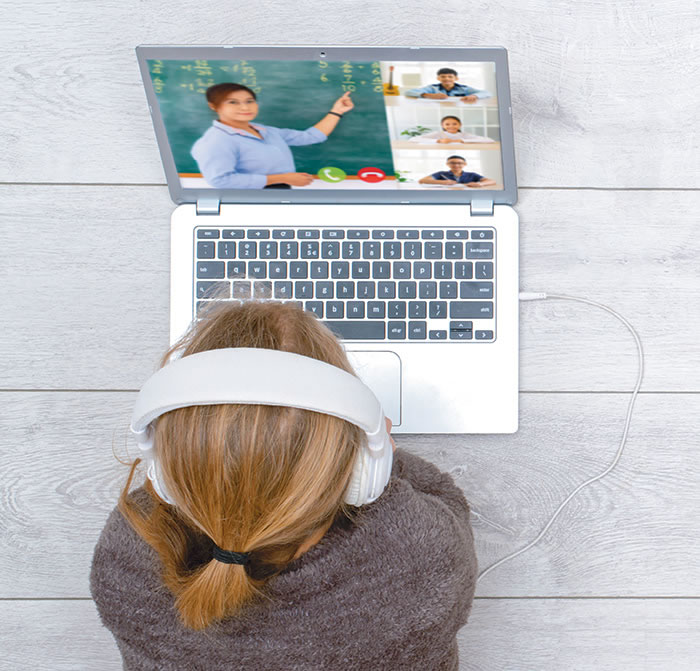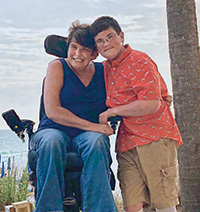
From a Distance

Students and educators share their experiences with online learning
When Faith Fortenberry’s elementary school closed in March because of the novel coronavirus pandemic, she missed seeing her friends and teachers every day. An outgoing 9-year-old living with spinal muscular atrophy (SMA), Faith thrives on social interaction. Even so, she found that online learning offered some advantages.
Faith, who lives in Woodway, Texas, often needs more time to complete schoolwork because weakened muscles in her hands and wrists make it difficult for her to hold a pencil. After her school switched to virtual learning, Faith — a third-grader at the time — began using her iPad’s speech-to-text function for writing assignments. For math problems, she could tap a number pad on the screen with one finger. This approach allowed her to work faster with less muscle fatigue.
“In some ways, she felt more successful because she could tackle things faster than having to write by hand,” says her mom, Leeann Fortenberry, a second-grade teacher.

Though Faith’s Individualized Education Program (IEP) allows her to use speech-to-text software rather than handwriting, Leeann hadn’t pushed for that option before. “We didn’t realize what a beneficial thing it was,” she says. Now, speech-to-text is a permanent part of Faith’s academic toolbox, whether she’s learning remotely or not.
Adjusting to virtual education
Faith was one of an estimated 55.1 million US students whose 2019-2020 school year was affected by the pandemic. This fall, Faith joined her fourth-grade classmates in person, but many children with neuromuscular diseases are continuing with full-time virtual learning or participating in a hybrid model that involves a mix of in-person and online instruction.
Many students — and school staff — with neuromuscular disease have found that the flexibility of online learning creates a more relaxed schedule. Cindy Hiestand, an elementary school speech therapist in Ringgold, Ga., who lives with Charcot-Marie-Tooth disease (CMT), missed her students but enjoyed the change of pace.
“I love not having to get all fancy for the day,” Cindy says. “Being in the comfort of my house and working with students by video is much less effort on my muscles.”
Taking away the stress of getting from one place to the next is especially helpful for college students, who often have to trek across expansive campuses for classes, meals, and extracurricular activities. Justin Moy, a junior at Worchester Polytechnic Institute in Massachusetts, estimates that he saved at least an hour each day after his classes moved online.
“Before COVID-19, just getting across campus took up a significant amount of time,” says Justin, who lives with congenital muscular dystrophy (CMD) and uses a power wheelchair. “I was able to use that time to get other things done, which was a boost to my productivity.”
The downsides of online learning
Students across the country are missing in-person interaction with peers and teachers as they continue to do their schoolwork from home. That lack of social stimulation combined with less movement throughout the day can have a negative impact on learning, particularly for students with neuromuscular disease.
“When your senses are fully engaged, with your body and mind active, you’re more alert and have more energy,” says Donnielle Rome-Martin, OTR/L, ATR, an occupational therapist and registered art therapist at Columbia University Medical Center Pediatric SMA Clinical Research Center and MDA Care Center. “When children are spending entire days in one position with less interactions, overall they may not be getting as cognitively stimulated.”

Donnielle recommends that parents and caregivers give kids learning at home opportunities for multiple positional changes throughout the day. That could be changing the tilt of their wheelchair, weight shifting, rolling to the side, ankle pumps with the feet, standing up for a few moments, or taking short sensory breaks. Donnielle recommends setting an alarm for every 20 minutes as a reminder.
“Any form of movement you may be able to engage in and incorporate throughout your day would be beneficial to lessen the impact of muscle deconditioning and help boost your learning experience,” Donnielle says.
Karen Doss Bowman is a freelance writer and editor living with progressive muscular atrophy, a subset of ALS, in Bridgewater, Va.
How IEPs and 504 Plans Are Affected

School closings amid the novel coronavirus pandemic in the spring affected 7.5 million special education students in the United States.
According to guidance from the US Department of Education (DOE) released in March, school systems are not required to provide services to students with disabilities if the general student population also is not receiving educational services. If the general population is provided with learning opportunities, students with special needs must be offered equitable access.
The DOE recommendation states that, “to the greatest extent possible, each student with a disability should be provided the special education and related services identified in the IEP or 504.”
The services students receive may look different now, possibly provided through virtual or online channels or in the student’s home.
“Whatever accommodations were already in place, they should be continued while students are at home,” says Sally Dunaway Young, PT, DPT, a physical therapist and clinical research manager with the Stanford University Neuromuscular Disorders Program. “Even though everyone is trying to be as flexible as possible, these services shouldn’t go out the window just because students are not in the school anymore.”

It’s critical for parents and caregivers to partner with their children’s special education team to ensure that students continue learning and developing while school buildings are closed. Cindy Hiestand, an elementary school speech therapist in Ringgold, Ga., has continued providing services for her students through FaceTime or other online platforms.
“The most important thing is having good communication with parents,” Cindy says. “Like me, the physical therapists and occupational therapists have been making videos and sending those to their kids, so parents can help their children. It’s really about good parent participation.”
5 Tips for Keeping Virtual Learning on Track

Living with a neuromuscular disease comes with a host of challenges, and it might feel daunting to add virtual classwork to the mix. These tips can improve the online learning experience.
- Stick to a schedule. Leeann Fortenberry, a second-grade teacher, developed a daily schedule that incorporated everything from instructional time with her own students and her daughter Faith’s schoolwork to exercises, free time, and outings. “We made a list of everything that was important to get done each day and prioritized it,” Leeann says.
- Be flexible. While keeping a routine is important, it’s also wise to be nimble. Things may not go as planned, and technology may fail. “Teachers have different technical levels, and family members also might not be able to help with the technology side,” says Justin Moy, a college junior studying bioinformatics and computational biology. “I believe in self-advocating, but also take into account the situations that teachers and caregivers are facing.”
- Take breaks throughout the day. One of the perks of virtual education is the ability to self-pace. Will Hiestand, 14, lives with Charcot-Marie-Tooth disease (CMT), like his mom, Cindy. When his high school went online, he found he was doing more typing than usual, which tired his hands, causing his fingers to go to limp. Cindy often had to persuade him to take a break. “As much as I hated it, taking breaks helped,” Will says. “It was nice to get on my bed, take my mind off the work for a little bit, and let my hands reset.”
- Continue physical and occupational therapy. If you can’t see physical, occupational, or speech therapists in person, you may be able to continue appointments through telehealth. “A therapist can support a patient who is struggling during this time and help build up confidence that they can do exercises on their own, even if they don’t have skilled hands touching them on a regular basis,” says Sally Dunaway Young, PT, DPT, a physical therapist and clinical research manager with the Stanford University Neuromuscular Disorders Program.
- Stay connected with friends and family. Online education can be isolating. For most students, missing out on daily interactions with friends and classmates has been the most challenging aspect of learning from home. Stay engaged with friends and family, and continue extracurricular or community activities whenever possible.
More Online
Watch Justin Moy and Chris Rosa, PhD, discuss facing back-to-school season while living with neuromuscular disease in the midst of the COVID-19 pandemic in a recorded Facebook Live event, MDA Frontline COVID-19 Response Back to School.
MDA Resource Center: We’re Here For You
Our trained specialists are here to provide one-on-one support for every part of your journey. Send a message below or call us at 1-833-ASK-MDA1 (1-833-275-6321). If you live outside the U.S., we may be able to connect you to muscular dystrophy groups in your area, but MDA programs are only available in the U.S.
Request Information